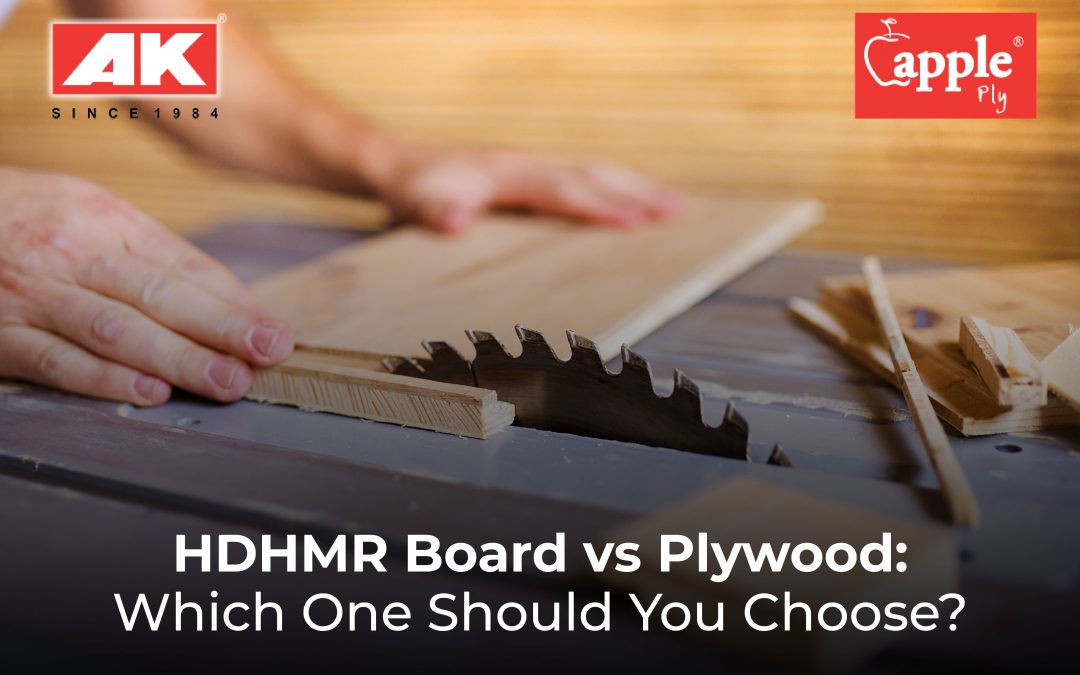We spend a fair amount of our time in our homes and therefore look for the best available material when we invest on furniture, or choose bedroom cupboards and kitchen cabinets. We also expect materials that are highly durable and resistant to all types of environmental factors like moisture, termites etc.
I’m sure most of you have this question – HDHMR board vs. plywood, which one is the better option for your home? Well, read on to find out more!
What is Plywood?
Plywood is a wooden board that has multiple layers of sheets which are pressed together for use in construction purposes. These sheets are called “plies”, which are made of the veneer of wood. Each of these sheets are glued together and attached. Plywood has a good resistance against moisture and is well-suited for use both indoors and outdoors.
Very often plywood is also called particle boards, chip boards or medium density fibreboards (MDF).
What are HDHMR Boards?
HDHMR (High Density High Moisture Resistance) Boards are more superior versions of plywood, because of their density and moisture-resistant properties. These HDHMR boards are also known as engineered wood boards and can withstand higher levels of moisture as compared to plywood.
This makes HDHMR boards very useful for use in outdoor furniture, doors, windows, shutters etc, where there are higher chances of moisture.
HDHMR Board vs. Plywood: Comparative Differences
Before we get into any other details, it is essential to know what’s different when it comes to HDHMR board vs. plywood.
This comparative chart will help you see the differences in their features side by side.
| Features | Plywood | HDHMR Board |
| Strength and durability | Very durable and is one of the strongest materials for building. Known to be “split-proof”. | Extremely durable and is known to be tougher than plywood. |
| Life expectancy of the material | Can last for over 15 years | Can last for over 15 years |
| Environmental protection | Can be susceptible to water damage over extended exposure, but its termite resistance is good. | Very high in its water resistance and is also completely safe from termites. |
Which Plywood is Best for Modular Kitchens?
The kitchen is the heart of a home and that’s why people look out for different ways to design and decorate their kitchen in the best way possible. Therefore, choosing the best plywood for your kitchen is very important.
Modular kitchens are designed contemporarily and are organized into cabinets, shelves and drawers. So, one of the best types of plywood to use for your kitchen would be Boiling Water Resistant (BWR) plywood.
It is made of superior quality, is highly durable and is both waterproof and resistant to moisture.
Your second option for modular kitchen use can be Boiling Water-resistant (BWR) plywood, which isn’t waterproof, but is water resistant or even HDHMR boards, as they have the same features as boiling water-resistant plywood.
HDHMR Board vs. Plywood: How do you make your choice?
By now it is clear that HDHMR boards seem to have an upper edge over plywood in terms of its durability, strength and protection against environmental factors. But it is important to decide on the material you are going to use based on what you’re constructing.
If you are looking at making partitions, using it as flooring or on your ceiling, using it for your cabinets or furniture, then plywood is a good choice. On the other hand, if you are thinking about making doors, shutters, kitchen cabinets, wall panels or in short, wherever there is a higher risk of exposure to moisture, then choosing HDHMR boards is a better option.
The HDHMR boards vs. plywood price depends on various factors like the type and thickness of the plywood, the thickness of the HDHMR boards you are looking to buy, area of coverage etc.
Read More: How To Use Veneer Sheets to Update Your Furniture?
Uses of HDHMR Board:
1. Interior Applications in Moisture-Prone Areas:
Ideal for use in bathrooms and kitchens where exposure to moisture is frequent. They are often used for bathroom vanities, under-sink cabinets, and other areas that require a moisture-resistant material.
2. Commercial Interiors:
Frequently used in offices, shops, and retail interiors due to their strength, durability, and resistance to wear and tear. HDHMR boards are perfect for making workstations, display units, partitions, and wall panels.
3. Outdoor Furniture and Applications:
Suitable for semi-outdoor furniture, such as garden chairs, patio tables, and park benches. Their water-resistant properties make them durable against occasional exposure to water or moisture.
4. Door Manufacturing:
HDHMR boards are a popular choice for creating flush doors due to their ability to withstand impact, resist swelling and offer enhanced stability over time.
Uses of Plywood:
1. Furniture Making:
Plywood is commonly used for a wide range of furniture, including tables, chairs, shelves, and cabinets. Its flexibility and strength make it ideal for both standard and custom furniture designs.
2. Interior and Exterior Paneling:
Plywood is frequently used for wall paneling, ceiling panels, and decorative cladding in both residential and commercial interiors. Exterior-grade plywood is used for facades and siding.
3. Construction Applications:
Used in construction for making formwork, shuttering, roofing, flooring, and subflooring due to its strength, structural integrity, and cost-effectiveness. It’s also used in building temporary structures, scaffolding, and barriers.
4. Packaging and Transportation:
Widely used for making crates, pallets, boxes, and other types of packaging materials due to its durability and lightweight properties.
5. DIY Projects and Crafts:
Plywood’s versatility makes it suitable for various DIY home improvement projects, such as bookshelves, toy boxes, and custom decor pieces.
6. Boat Building and Marine Applications:
Marine-grade plywood is specifically designed for building boats, docks, and other marine applications due to its high resistance to water and moisture.
Conclusion
Lastly, if you are looking for HDHMR board manufacturers in India, then AK Plywoods is your go-to company. AK Plywoods is committed to delivering high quality and durable products that will ensure that your home has high standard ply interiors and exteriors.
So if you are searching for the Best Plywood Company, choose AK Plywoods and you’re sure to not only get a good deal, but also get superior quality plywood that elevates your home experience.
Our Products: BWR Grade | BWP | Calibrated Plywood | Blockboard | Laminates | Louvers | Veeners
New Technologies: Discuss any recent innovations or trends in HDHMR board and plywood technology, such as new manufacturing processes, improved materials, or emerging applications.
Future Outlook: Provide insights into how the industry is evolving and what future developments might mean for consumers and builders.
FAQs (Frequently Asked Questions):
1. Can HDHMR be used for wardrobes?
Absolutely, HDHMR is a great option for wardrobes and various interior applications. Its durability and resistance to moisture make it an ideal choice for furniture building.
2. Is HDHMR safe for health?
HDHMR boards may emit fumes that could cause irritation and have potential long-term health effects. To ensure safety against harmful fumes, always go for low-emission HDHMR boards that are designed to be safer and healthier for you and your environment.
3. What are the key benefits of HDHMR boards over plywood?
HDHMR boards offer superior water resistance, termite protection, and physical durability compared to plywood. They also provide a more consistent surface and are less likely to warp, making them ideal for high-moisture environments and demanding uses.
4. Can plywood be used instead of HDHMR boards?
While plywood is versatile, HDHMR boards are a better choice for areas with high moisture or where durability is crucial. In moisture-ridden areas, plywood may not match the water resistance and robustness of HDHMR boards.
5. How does the strength of HDHMR boards compare to plywood?
HDHMR boards are typically stronger and more impact-resistant than standard plywood due to their higher density and consistent composition. This makes them perfect for challenging applications.
6. What should I consider when choosing between HDHMR boards and plywood?
It’s important to consider the specific conditions and durability needs of your project. HDHMR boards are ideal for high-moisture and high-traffic areas, while plywood may be suitable for less demanding applications if properly treated.




